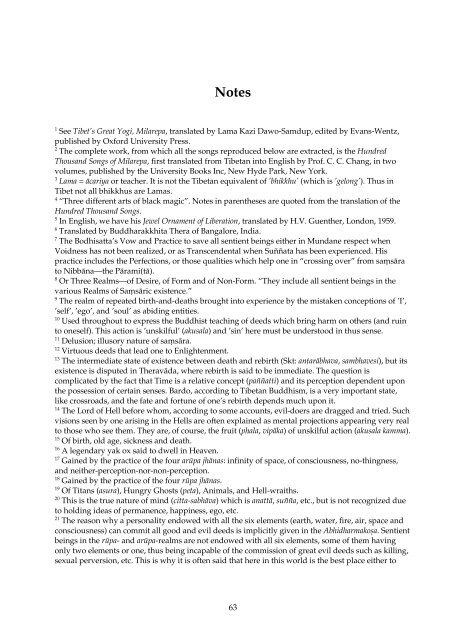Sixty Songs of Milarepa - Buddhist Publication Society
Sixty Songs of Milarepa - Buddhist Publication Society
Sixty Songs of Milarepa - Buddhist Publication Society
Create successful ePaper yourself
Turn your PDF publications into a flip-book with our unique Google optimized e-Paper software.
Notes<br />
1<br />
See Tibet’s Great Yogi, <strong>Milarepa</strong>, translated by Lama Kazi Dawo-Samdup, edited by Evans-Wentz,<br />
published by Oxford University Press.<br />
2<br />
The complete work, from which all the songs reproduced below are extracted, is the Hundred<br />
Thousand <strong>Songs</strong> <strong>of</strong> <strong>Milarepa</strong>, first translated from Tibetan into English by Pr<strong>of</strong>. C. C. Chang, in two<br />
volumes, published by the University Books Inc, New Hyde Park, New York.<br />
3<br />
Lama = ācariya or teacher. It is not the Tibetan equivalent <strong>of</strong> ’bhikkhu’ (which is ’gelong’). Thus in<br />
Tibet not all bhikkhus are Lamas.<br />
4<br />
“Three different arts <strong>of</strong> black magic”. Notes in parentheses are quoted from the translation <strong>of</strong> the<br />
Hundred Thousand <strong>Songs</strong>.<br />
5<br />
In English, we have his Jewel Ornament <strong>of</strong> Liberation, translated by H.V. Guenther, London, 1959.<br />
6<br />
Translated by Buddharakkhita Thera <strong>of</strong> Bangalore, India.<br />
7<br />
The Bodhisatta’s Vow and Practice to save all sentient beings either in Mundane respect when<br />
Voidness has not been realized, or as Transcendental when Suññata has been experienced. His<br />
practice includes the Perfections, or those qualities which help one in “crossing over” from sasāra<br />
to Nibbāna—the Pārami(tā).<br />
8<br />
Or Three Realms—<strong>of</strong> Desire, <strong>of</strong> Form and <strong>of</strong> Non-Form. “They include all sentient beings in the<br />
various Realms <strong>of</strong> Sasāric existence.”<br />
9<br />
The realm <strong>of</strong> repeated birth-and-deaths brought into experience by the mistaken conceptions <strong>of</strong> ’I’,<br />
’self’, ’ego’, and ’soul’ as abiding entities.<br />
10<br />
Used throughout to express the <strong>Buddhist</strong> teaching <strong>of</strong> deeds which bring harm on others (and ruin<br />
to oneself). This action is ’unskilful’ (akusala) and ’sin’ here must be understood in thus sense.<br />
11<br />
Delusion; illusory nature <strong>of</strong> sasāra.<br />
12<br />
Virtuous deeds that lead one to Enlightenment.<br />
13<br />
The intermediate state <strong>of</strong> existence between death and rebirth (Skt: antarābhava, sambhavesi), but its<br />
existence is disputed in Theravāda, where rebirth is said to be immediate. The question is<br />
complicated by the fact that Time is a relative concept (paññatti) and its perception dependent upon<br />
the possession <strong>of</strong> certain senses. Bardo, according to Tibetan Buddhism, is a very important state,<br />
like crossroads, and the fate and fortune <strong>of</strong> one’s rebirth depends much upon it.<br />
14<br />
The Lord <strong>of</strong> Hell before whom, according to some accounts, evil-doers are dragged and tried. Such<br />
visions seen by one arising in the Hells are <strong>of</strong>ten explained as mental projections appearing very real<br />
to those who see them. They are, <strong>of</strong> course, the fruit (phala, vipāka) <strong>of</strong> unskilful action (akusala kamma).<br />
15<br />
Of birth, old age, sickness and death.<br />
16<br />
A legendary yak ox said to dwell in Heaven.<br />
17<br />
Gained by the practice <strong>of</strong> the four arūpa jhānas: infinity <strong>of</strong> space, <strong>of</strong> consciousness, no-thingness,<br />
and neither-perception-nor-non-perception.<br />
18<br />
Gained by the practice <strong>of</strong> the four rūpa jhānas.<br />
19<br />
Of Titans (asura), Hungry Ghosts (peta), Animals, and Hell-wraiths.<br />
20<br />
This is the true nature <strong>of</strong> mind (citta-sabhāva) which is anattā, suñña, etc., but is not recognized due<br />
to holding ideas <strong>of</strong> permanence, happiness, ego, etc.<br />
21<br />
The reason why a personality endowed with all the six elements (earth, water, fire, air, space and<br />
consciousness) can commit all good and evil deeds is implicitly given in the Abhidharmakoa. Sentient<br />
beings in the rūpa- and arūpa-realms are not endowed with all six elements, some <strong>of</strong> them having<br />
only two elements or one, thus being incapable <strong>of</strong> the commission <strong>of</strong> great evil deeds such as killing,<br />
sexual perversion, etc. This is why it is <strong>of</strong>ten said that here in this world is the best place either to<br />
63
















